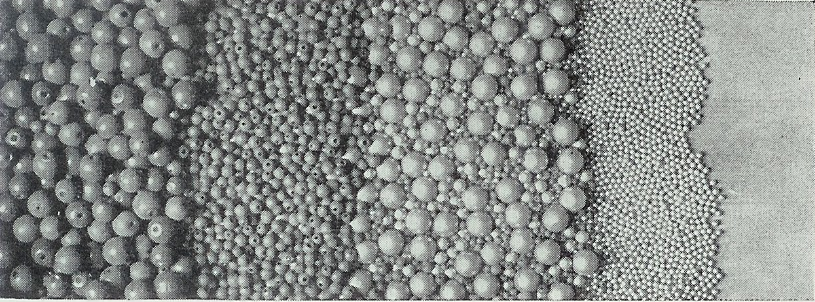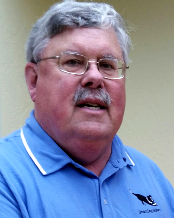
SMART DOG MININGTM
It
takes a smart dog to find hidden treasures
An Introduction to Gravity Concentration
Gravity concentration is the separating of particles by their
relative densities (specific gravity). Gravity concentrating has
been used to process minerals for a long time, Agricola in De Re
Metallic (1556) reported the use of gravity concentrating (jigging)
by the Egyptians around 1000BC (3000 years ago). Gravity
concentrating is still used in mining for separating the values from
the waste; whether gold form rock, or coal from waste, or gems from
the host rock.
PARTICLE SETTLING
The basic principle behind gravity concentrating is related to how a
particle will settle in a fluid. By Stokes law, with no other
factors being considered (free settling), particles of the same size
in a fluid will achieve a settling velocity dependent on two times
their relative densities in relation to the fluid density. Also from
Stokes law particles of the same relative density will achieve a
settling velocity dependent on the square of their size.
While simple settling defines the action of a single particle in a
fluid, in actually practice there are many particles of differing
density and size. In addition there are boundaries to the fluid
which also impact the settling. These add drag to the particles, the
drag forces of the fluid, other particles, and the vessel the
settling is occurring in, as defined by Reynolds number for various
conditions, effect the settling.
Settling is more complicated because of these other particles, and
is the interrelation of three factors; hindered settling,
differential acceleration, and consolidation trickling. In the
simplest processes (such as in riffles or stream beds) the main
actions are hindered settling and consolidation trickling. Jigging,
tables, and even pans add differential acceleration.
In hindered settling, larger and heavier (denser – high specific
gravity) particles will settle sooner than smaller or lighter
particles, and move farther. Part of this comes from the ability of
the larger heavier particles to push their way through the other
particles, and part comes from relative fluid flow rates needed to
keep particles in suspension.
In the differential acceleration, larger particles, having a bigger
area to work on, move farther and faster than smaller particles with
a similar density. Heavier (denser) particles (higher specific
gravity) will start moving slower on an acceleration cycle and
faster on a settling cycle than particles of the same size, they
will also tend to move less on acceleration (inertia) and farther on
the settling (again inertia).
In the final stages of settling, the consolidation trickling
portion, the larger particles have stopped moving but the smaller
particles will continue to move downward through the larger
particles. This difference in movement will cause the heavier
particles to end up or concentrate to the bottom of a bed, and the
bed to have layers, with the smallest particles on the bottom. This
is shown in Figure 1.
Figure 1 – Particle Settling Actions

In the above picture (figure 1) the shaded particles are heavier
(higher specific gravity) than the open particles.
Figure 2 – Mixture of Wood and Steel Balls

A mixture of wood and steel balls of various sizes before applying
gravity concentration. The wood balls have holes to help identify
them from the steel balls.
Figure 3 – Results of Particle Settling

The same mixture after gravity concentration, showing the various
layers. Layers of similar size and density materials have been
picked off to help show the layering.
The above describes what happens with particles of the same shape,
but particles are not all the same shape. Round and cubical
particles will behave as described, but flatter particles distort
this simple process.
Two particles of the same size and density will act differently if
one is flatter than the other. The flatter particle will act as if
it had a lower density, if the flat side is oriented in the
direction of the fluid movement, and heavier if it is oriented
opposite to the movement. Think of skipping rocks.
SETTLING SUMMARY
Hindered settling – how a particle moves downward through a mixture
of water and other particles depends on it’s size, shape and
density.
Differential acceleration – how quickly a particle moves depends on
it’s size, shape and density.
Consolidation trickling – during final stages of settling, the
larger particles have stopped moving but the smaller particles will
continue to move downward through the larger particles.
In simple processes (jigging, tables, spirals, and sluices) the
fluid is water (or in some cases air). In dense media the fluid is a
mixture of magnetite, ferrosilicon or similar. Some operations have
used dense liquids (salt solutions being the original, and now
organic chemicals). Centrifuges and cyclones also increase the force
by adding centripetal force greater than just gravity acceleration.

o
40+
years’ experience in the mining industry with strong mineral
processing experience in Precious metals, copper, industrial
minerals, coal, and phosphate
o
Operational experience in precious metals, coal, and phosphate plus
in petrochemicals.
o
Extensive experience studies and feasibility in the US and
international (United States, Canada, Mexico, Ecuador, Columbia,
Venezuela, Chile, China, India, Indonesia, and Greece).
